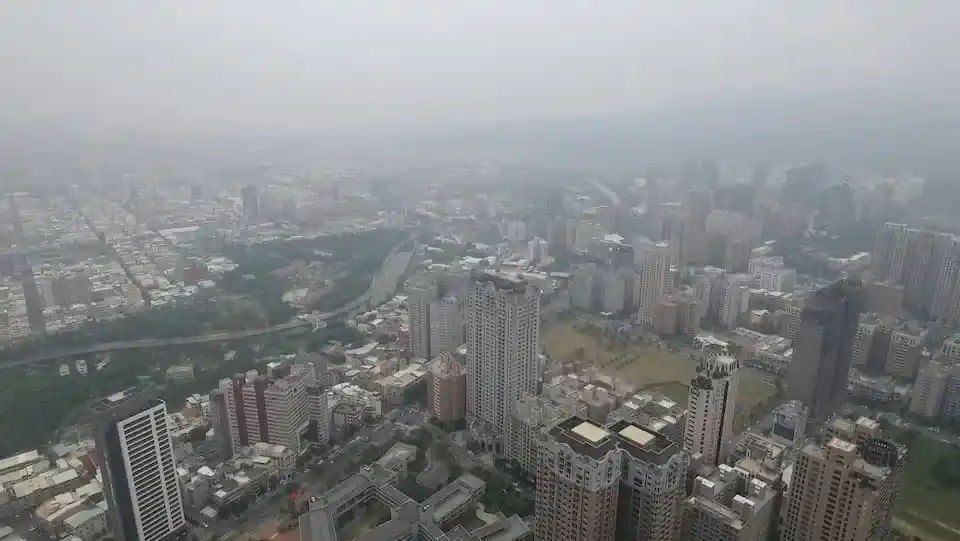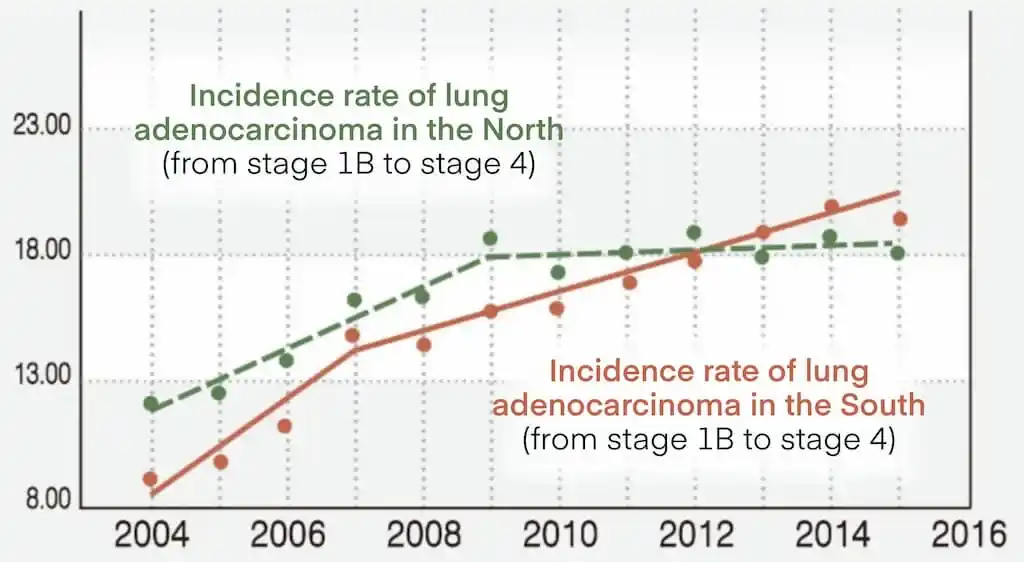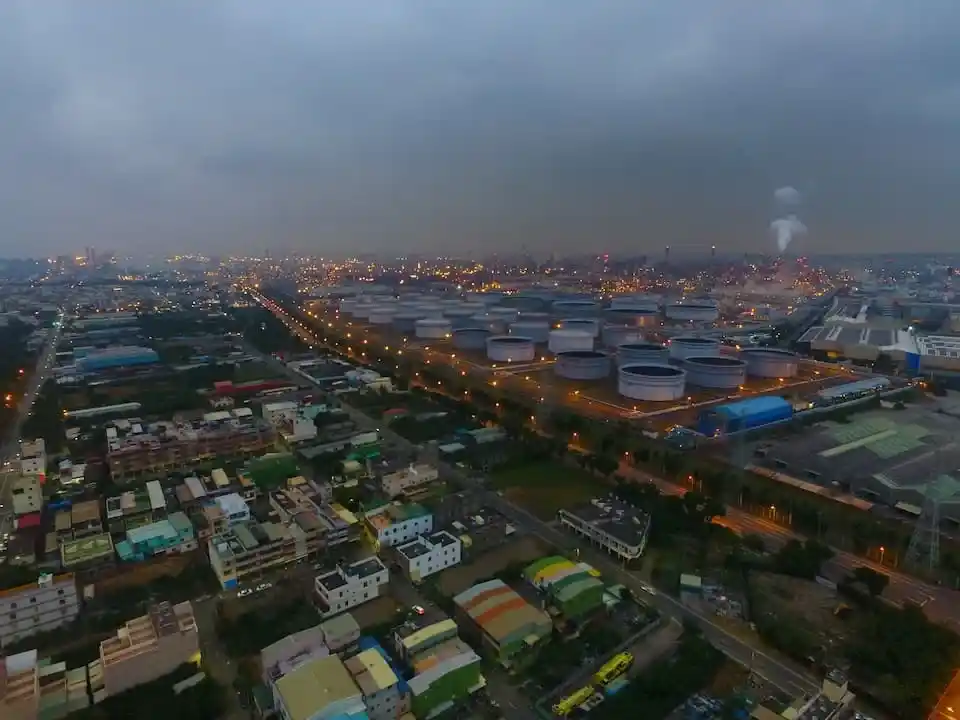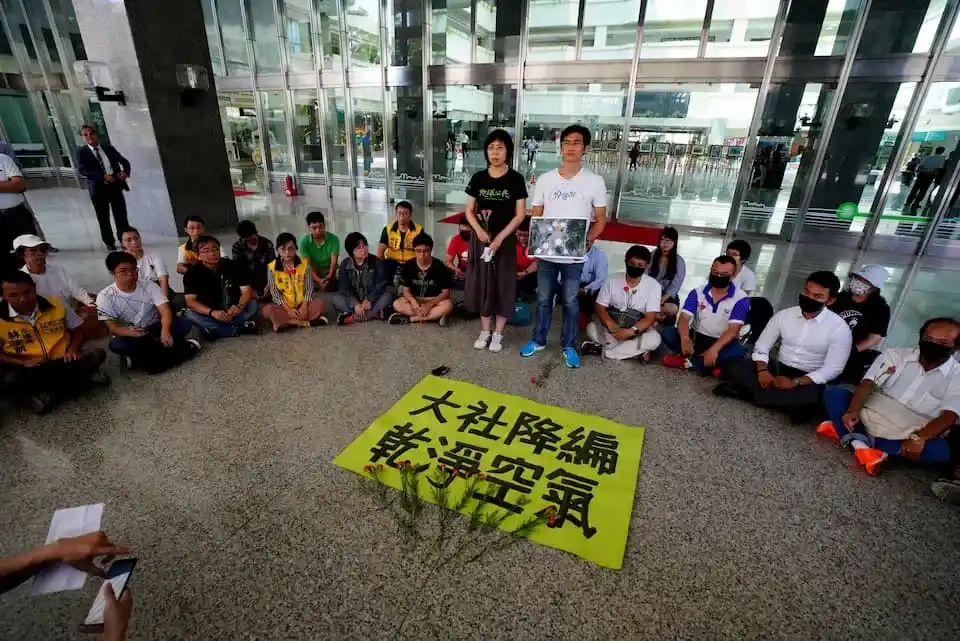Author/Wang Minling, Deputy Chief Executive Officer, Citizen of the Earth, Taiwan

Figure 1: Air pollution season in Kaohsiung City
Source: Earth Citizens Foundation (Taiwan).
"The man, who often goes jogging with me, texted me early this morning and said that he needs to go to the hospital these days, so he can't join with us recently."
"The aunt who sells rice balls behind the alley is waiting for the slice report. She said that she didn't go to register until her sister detected the cancer."
Living in the south of Taiwan, the above dialogues are not unusual. We heard more and more news of cancer from friends, relatives or neighbors. For many years, at the air pollution symposium organized by the local environmental protection bureau, or at the public hearing on the amendment of air pollution related bills handled by the Environmental Protection Administration (EPA), I often heard friends from Kaohsiung and Pingtung telling me that they are worried about getting cancer - includes elderly residents living near the industrial zone and young parents who have just paid a few years of housing loans in the Kaohsiung metropolitan area.
Is it just because of the nature of my job that I heard it more often? I used to be skeptical.
This confusion was finally solved after Dr. Chien-Hua Tseng of Taipei Medical University published the paper "The Relationship Between Air Pollution and Lung Cancer in Nonsmokers in Taiwan in Nonsmokers in Taiwan" in the international journal "Chest Cancer" in May this year.
Dr. Tseng's research found that since 2007, the annual growth rate of lung adenocarcinoma in Kaoping Air Quality Zone has reached 4.6%, which is about 15 times of which (0.3%) in northern Air Quality Zones (including Keelung, Taipei, New Taipei City, and Taoyuan). In other words, in the past 10 years, the number of patients with lung adenocarcinoma in Kaohsiung and Pingtung has increased rapidly, and the cases that we "hear more and more often"are reflecting the facts instead of coincidences. This study combines the participation of scholars from Taiwan University, Chung Hsing University, Yangming University, National Institutes of Health, and Taiwan Cancer Registry. From the data of more than 370,000 patients with lung cancer, this study found that from 1995 to 2015, not only does the incidence of lung adenocarcinoma continue to skyrocket, and the incidence of lung adenocarcinoma in women, which was originally lower than that of men, has risen all the way to a higher incidence of lung adenocarcinoma than men (women have grown from 7.05 per 100,000 to 24.22 per 100,000, while men grew from 9.06 per 100,000 to 23.25 per 100,000). It is worth noting that more than half (53%) of lung cancer patients do not smoke.
As we all know, there are many and complicated causes of cancer, but the air pollution factors, especially PM2.5 (Suspended particulates) pollution, which are believed to be associated with lung adenocarcinoma, have been reported in various countries' studies. It is also an indisputable fact that the air quality of Kaoping district has been extremely poor in the past 40 years, as Dr. Tseng said in an interview with the United Daily News: "This study not only shows that air pollution may be a key factor for non-smokers to develop lung cancer, but also remind us that the external costs of long-term air pollution in Taiwan have already surfaced."[1]

Figure 2: Trend of incidence of lung adenocarcinoma in the north and the south of Taiwan
Source: Luo Zhen and Chen Jiechi. (2019). "Trends in the incidence of lung adenocarcinoma from the north to the south", United Daily News.
Note: North Taiwan refers to Taipei, New Taipei, Keelung, Taoyuan; South Taiwan refers to Kaohsiung and Pingtung. Annual rate of lung adenocarcinoma in Kaoping area is 15 times that of northern Taiwan.
External costs? Just from the perspective of health effects, industrial development has caused pollution in Kaohsiung for more than 70 years. If you want to carefully measure the damage to the health of Kaohsiung people, you can really write a history of blood and tears.
In 1946, the CPC company established the Kaohsiung Refinery at the original sixth fuel plant of the Japanese army in Nanzi Hengjin. After repairing the facilities, the crude oil was imported in 1948 to start distillation and refining. Since then, local children have stopped jumping into Houjinxi to take a shower after school, and the Kaohsiung and Pingtung areas are gradually getting dusty. Also leaning on the foothills of the Ban Ping Mountain is the highly polluted cement industry. After the completion of the No. 1 kiln of Southeast Cement in 1958, the smoke and dust were released randomly, emitting black smoke and odor. In 1968, the CPC company also entered the petrochemical industry, and the first and second light oil cracking sites began to operate in the refinery area.Nanzi, Taishe, and Renwu are occupied by the chimneys and coal bunkers of the petrochemical industry and the symbiosis of steam and electricity (coal).
I remember an elder once told me that back then, black smoke was a part of daily routine. In 1969 and 1970, two coal-fired units (total 600,000 kilowatts) of Taipower Dalin Power Plant in Xiaogang District, South Kaohsiung, were in operation. Two years later, the third and fourth oil-fired units (with a total of 750,000 kilowatts) were added. Waterfront Industrial Area, where hundreds of factories such as China Steel and CSBS Corporation have stationed, coating dust into the sky day and night.

Figure 3: Oil tanks, chimneys in Waterfront Industrial Area are adjacent to Dalinpu Community
Source: Earth Citizens Foundation (Taiwan).
The external cost of Kaohsiung's development of heavy industry for decades has been transformed into a red curve of lung adenocarcinoma that surpasses which of the north of Taiwan in 2012 in the papers of Dr. Tseng and other scholars. But is Kaohsiung and the Pingtung people bearing only the dazzling red line? If you visit Lin Yuan, you will know that there is a street secretly called "Liver Cancer Street". If you visit the neighborhood of Dashe, you will hear that many people have blood cancer.
Back in August, after the media disclosed the research report, the EPA issued a press release immediately, suggesting that the air pollution emissions in the Kaoping area in the past 4 years have decreased from 198,403 tons (2015) to 182,448 tons (2018), a total reduction of 15,958 tons. They also announced that the annual average of PM2.5 in the high-screen empty area has decreased from 23.5 μg/m3 (2015) to 18.7 μg/m3 (2018), showing an improvement of 22%.[2]
However, in recent years, the tide of long-term dissatisfaction with air pollution in the central and southern regions has been extremely significant, and many people have participated in the anti-air pollution procession called by civil society. Public opinion is such that it is not an exaggeration to reduce the amount of air pollution by 15,958 tons in Kaoping area in four years. But many Kaohsiung friends who care about air pollution asked me when they saw the news:
"What! Has the amount of air pollution in Kaoping areas dropped to 18.7 μg/m3? Then it is not far from 15 μg/m3 (PM2.5 air quality standard). But the air quality still shows orange or red light frequently. Has it really improved that much? "
"The southern part of Taiwan was still gray last winter. Is the official statistic forged again?
To answer this question, we must first understand that the monitoring of PM2.5 is divided into manual measurement stations and automatic measurement stations. Manual monitoring is manually set out and sampled, and the measured values are obtained continuously for 24 hours. Sampling is performed every 3 days, and data is transmitted every minute. This kind of measurement is different from Air Quality Index (AQI).[3] The annual average value of PM2.5 of Kaoping area is 18.7 μg/m3, which is obtained by averaging the annual average of PM2.5 in four manual monitoring stations set up by the Environmental Protection Agency in 2018. In other words, it passed through Mino Station (the statics of which is the lowest or at least lower than most of the stations in Kaohsiung in recent years) and Hengchun Station (the air quality is similar to Taitung, which is considered to be one of the cleanest areas in Taiwan) and therefore dilute the result of PM2.5 concentrations in Kaoping area. Eventually, the dilution made the "achievement"of 18.7 μg/m3. (See Table 1 for more details)
Table 1: Annual average of Kaoping area's PM2.5 manual monitoring stations in 2018
|
Monitoring stations |
Annual Average of PM2.5 |
|
Mino Station |
19.7 |
|
Cianjin Station |
23.8 |
|
Pingtung Station |
23.9 |
|
Hengchun Station |
7.4 |
|
Average |
18.7 |
Unit: μg/m3
Source: EPA
Of course, the EPA can say that the officially released data is compared with 2015 which also took the average of the data of these 4 stations, that is, under the same comparison benchmark, the data showed "improvement"in air quality. This part is not difficult to understand. The problem is the question mark casted in people's mind when they see the data of 18.7μg/m3. After all, most people in Kaoping Area still feel that the problem of air pollution is severe.
The places where most Kaoping residents live are Zuoying, Renwu, Fongshan, Chaozhou, etc., which are close to the environmental quality of Cianjin and Pingtung stations, where the annual average value of manual monitoring of PM2.5 is about 24μg/m3, which is only slightly lower than Douliu and Chiayi stations (25, 24.5μg/m3 respectively) and much higher than the data of other stations in Taiwan. Also, according to the EPA, the annual average of the PM2.5 automatic monitoring station of Kaohsiung Nanzi and Dajing stations are even the two most severe ones in Taiwan (Nanzi 27.7μg/m3, Datong 27.6μg/m3). In short, the data of PM2.5 in Kaoping Area released by the EPA is not much of counterfeit numbers, but it is absolutely far from the feelings of the public!
Furthermore, the air quality in summer is better than autumn and winter in Kaoping Area. So, it is easy to beautify the air quality number with a year-long average. In addition to PM2.5, the other factor of air pollution is the high level of concentration of ozone. Let's use the AQI including ozone, carbon monoxide, sulfur dioxide, nitrogen dioxide, PM2.5, PM10 (suspended particulates) to examine the air pollution in the most severe seasons of "general station" in Kaoping Area (excluding Hengchun station) in the past two years. The results are as follows:
From October 2018 to March 2019, compared with the same period of previous year, the AQI did decline and improve for 4 months, but there were still 2 months of increase and deterioration. (See Table 2 for details). More importantly, during the 6 months of air pollution season, the lowest AQI value of Kaohsiung, Pingtung, Yunlin, Chiayi, and Tainan (five counties in the south of Taiwan) was 78 in the Yunjianan (Yunlin, Chiayi, and Tainan) Air Quality Zone in December 2018. Which is to say that residents of this five counties and cities didn't enjoy even a month of good air quality (AQI equal to or lower than 50), and not even AQI near to 50. This is why the people have no sense of the government's so-called "improvement”!
Table 2: AQI of YunJianan and Kaoping Air Quality Zone in air pollution seasons from 2017
|
2017/10-2018/03 |
2018/10-2019/03 |
|||
|
Air Quality Zone |
YunJianan |
Kaoping |
YunJianan |
Kaoping |
|
Oct. |
85 |
94 |
107 |
116 |
|
Nov. |
83 |
107 |
91 |
98 |
|
Dec. |
93 |
102 |
78 |
94 |
|
Jan. |
82 |
97 |
98 |
107 |
|
Feb. |
100 |
97 |
89 |
83 |
|
Mar. |
100 |
99 |
87 |
86 |
Source: compiled from the EPA website.
Notes: The data is from the general air quality automatic station of the EPA. In Kaoping Area, the stations include Mino, Nanzi, Renwu, Zuoying, Cianjin, Siaogang, Daliao, Linyuan, Pingtung and Chaozhou.
After the Tsai government took office, she handed over the EPA to Director Yingyuan Li,[4] while the air pollution was supervised by Shungui Zhan, who was former deputy director of EPA. After more than two years of hard work, a new version of the air pollution law was drawn up. The revision covered many aspects and spawned many subsidiary legislations. Among them, the well-reputed public information disclosure on the management of stationary pollution sources had responded to the demands of environmental groups and the public over the years and thus made a significant progress. As for whether the harmful air pollutants which make people in the industrial areas suffered can be greatly tightened, it is still under observation.
On the whole, the improvement which expected by residents of Yunjianan and Kaoping Area in the severely polluted areas cannot rely entirely on the EPA. The Ministry of Economy and the Ministry of Transport cannot evade their responsibilities, too. In particular, the commitment of 10 petrochemical plants of the Kaohsiung Taisha Corporation to be reduced to a B-type industrial zone has been bounced last year.[5]Whether it can be fulfilled before the election, everyone in Kaohsiung is watching. Of course, it is an important part of air quality improvement. In addition, there are still some important aspects like that whether the DalinPu Village can be relocated, and the so-called new material recycling park can really lead Taiwan to abandon old industries and open up a new look for a circular economy with zero waste, zero emissions and zero accidents.
When asked about the problem of lung adenocarcinoma in Kaoping area, President Tsai only responded lightly, "we will pay more attention to the North-South balance and the air pollution issue." I'm now urged the overturn of industrial policies; the pragmatic explanation of air quality and the thorough improvement should begin now. Southerners have complained about environmental injustice for decades!
Figure 4: Press conference of the Earth Citizens Foundation and the Dashe Environmental Protection Alliance in front of the Kaohsiung City Government
Source: Earth Citizens Foundation (Taiwan).

This work is licensed under a Creative Commons Attribution-NonCommercial-NoDerivatives 4.0 International License.
※The aforementioned may not be copied for commercial use without the center's consent, thank you.※


(1) Luo Zhen (2019). "Study shows that the increase rate of lung cancer in Kaoping area is 15 times than that in the north and patients have shorter life spans", United Daily News, August 21.
(2) Air Security Division of the EPA (2019). "The air quality in the Kaoping area has improved by 20% in the past four years, and the Environmental Protection Agency continues to protect the health of our people."
(3) According to the EPA, in order to make the automatic and manual monitoring of the data consistent, it has since May 2014 conducted linear (relational) regression to correct the automatic monitoring data and this was also done retrospectively until January 2014. In other words, the current PM5 AQI values therefore differ from the PM2.5 values in the past, because the current indicator is not based on the original data, but has been adjusted, leading to accusations by civil society groups of an attempt to downplay the numbers. It was not until September 25, 2019, after the EPA updated all its PM2.5 automatic monitoring instruments in Taiwan, that the PM2.5 data was no longer corrected by regression.
(4) From January 14, 2019, former Deputy Minister Chang Tzi-Chin will serve as the Minister of the EPA.
(5) On May 3, 1993, Former Deputy President of the Legislative Yuan Wang Jin-pyng arranged for a dispute coordination meeting to be held in relation to the pollution caused by the Tashe Petrochemical Industrial Zone, and presided over by former Kaohsiung County head Yu Chen Yue-ying. Based on the outcome of the meeting, Former Minister of Economic Affairs later issued an official document that required all the petrochemical plants at the Tashe Petrochemical Industrial Zone to be relocated together with the Fifth Naphtha Cracker facility. Subsequently on February 5, 1998, the Taiwan Provincial Government issued its approval after a third review by the Kaohsiung County government's Tashe City Plan. Among the amendments made to the plan were that the relocation of the petrochemical plants had to be completed by 2018, and then be reclassified under the law as a Class B Industrial Zone by the county government.